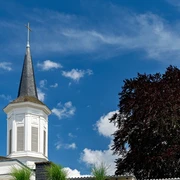- Photos & Map
How would you like to arrive?
- Website
- Description
- Good to know
- Nearby
The St.-Johannes church is a three-aisled basilica in the Neo-Romanesque style. It has a transept, one west and two east towers. The church is 67 meters long, or 75 meters including the walls and stairs, 44 meters wide and with a clear height of the middle aisle of 20.5 meters. The two east towers are each 41 meters high, while the west tower (with cross and weathervane) is 83 meters high.
The church has a large collection of artworks and art objects. Some of the art objects, such as a host box from the 16th century, monstrances and chasubles from the Renaissance period, are exhibited in the Diözesanmuseum zu Paderborn (the diocese museum in Paderborn).
The oldest and most valuable work of art in the church is the triumph cross, which was produced at the end of the 13th century and the beginning of the 14th century. It is made of oak and bears the symbols of the four evangelists on the ends of the cross.
In the church, there are seven altars: the high altar of 1893, the Maria altar of 1894, the Johannes altar of 1894, the Barbara altar, the heart of Jesus altar and the celebration altar. When the interior was last renovated, a workday church with its own small altar was set up in the choir between the celebration and high altars.
The heart of Jesus altar contains the cross ostensorium, a monstrance-type instrument for presenting the cross relics. It was made during the second half of the 19th century. In around 1780, the Johannes church was presented with the cross relics from the imperial treasury in Vienna. It is claimed that a real, larger piece of Jesus’ cross is contained there. The cross particles are in an oval, silver capsule, which was produced in 1779. The altarpiece was created by the Neheim painter Ritterbach. It shows the Johannes church in the background with the west tower and the former town hall, as well as portraits of Neheim citizens.
The Sixtine Madonna is also worth noting: a painting created after the painter Raffael. It was a gift from the Crown Prince of Prussia.
The station images of the Stations of the Cross were produced in 1881 by the Munich painter Franz Krombach. They were housed in St. Marien, Kamen-Methler, until 1979.
In 1929, after more than a year of construction work, one of the largest organs of the archdiocese of Paderborn, and at that time one of the largest instruments in the country, was produced. The company, Anton Feith in Paderborn (formerly Eggert – today organ builders Siegfried Sauer, Höxter) had modelled it on the Paderborn cathedral organ, which had been built shortly before. 58 registers were distributed over three manuals and pedals on the main organ in the west tower, and today, 14 registers still form unchanged the 14 remote consoles above the arch in front of the high choir. The organ has been restored and modified several times.[2]
Good to know
Openings
Price info
General information
Parking Available
Bus stop available
Author
Organization
Sauerland-Tourismus e.V.
License (master data)
Annette Baumeister Stadt Arnsberg
Nearby





